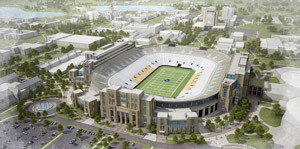 Conceptual sketch of Notre Dame Stadium. Larger image
Conceptual sketch of Notre Dame Stadium. Larger image
The University of Notre Dame announced today (May 2) that it is exploring an innovative approach to campus planning that would take advantage of the central location of the football stadium to make it a hub for, among other possibilities, a student center, media center and classroom and conference center.
“Inspired by the University’s campus master plan, we will study the possibility of accomplishing multiple objectives — namely, preserve the campus’ pedestrian character by taking advantage of a central location for needed facilities, retain the integrity of a legendary stadium, improve the visual attractiveness of the exterior stadium wall, and enhance the game day experience for our football fans,” Rev. John I. Jenkins, C.S.C., the University’s president, said after presenting an outline of the initiative to members of the Board of Trustees at its spring meeting.
Potential areas of examination include constructing additions to the stadium to provide:
- Space for classrooms, conferences, speakers, meetings, receptions and other events.
- A student center for assembly and activity areas.
- Resources for media, including facilities for the University’s expanding video and digital initiatives for academic purposes and external relations, as well as a press box.
- A location for various hospitality functions for community and campus patrons.
- Enhancements to the fan experience, including premium seating options.
The study will include representatives from the offices of the Provost, Student Affairs, Executive Vice President, University Relations and Architect, Notre Dame Athletics and other departments, as well as outside consultants.
Costs and other details related to possible projects will be unknown until specific plans — if any — are put in place. Under all circumstances, however, the University will keep the original stadium intact.
Notre Dame Stadium opened in 1930 and was expanded to its current configuration in 1997. One of the nation’s most iconic athletics venues, it is used fewer than 10 times annually for home football games, RecSports events, and the University Commencement Ceremony.